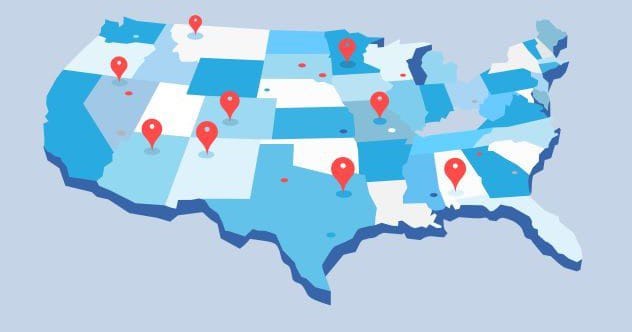The United States is known as a land of innovation, with states proudly claiming various ‘firsts.’ While aviation achievements often spark debates between North Carolina and Ohio, every state boasts unique historical milestones. But what about the unusual and unexpected ones? Here’s a look at ten surprising state ‘firsts’ you probably haven’t heard of—quirky, funny, and certainly memorable!
10. Alabama: The First 911 Call
In 1968, Haleyville, Alabama, made history with the first 911 call. Before this, the emergency number was simply ‘0,’ connecting callers to an operator. Recognizing the need for a dedicated dispatch system, Haleyville was the first to implement 911 on February 16, 1968. Alabama’s speaker of the house made the inaugural call to Congressman Tom Bevill, ensuring the line’s functionality. This quick implementation, following Congress’s mandate, solidified 911 as America’s nationwide emergency number.
9. Florida: The First Sunscreen
In 1944, Miami, Florida, became the birthplace of sunscreen, thanks to pharmacist Benjamin Green. As an airman during World War II, Green’s medical knowledge and love for surfing led him to create a lotion that would tan skin without the harsh sunburns. This invention quickly gained popularity among Miami residents, leading to the creation of the Coppertone brand. Green’s innovation revolutionized outdoor sun protection.
8. Iowa: The First Computer
Before Silicon Valley, there was Ames, Iowa. In 1937, Iowa State University physics professor John Vincent Atanasoff, along with graduate student Clifford Berry, began developing the world’s first electronic computer. By 1942, the Atanasoff-Berry Computer (ABC) was complete, featuring rotating drums for memory, a read/write system, vacuum tubes, and binary arithmetic. Though massive and weighing over 750 pounds, the ABC Computer paved the way for modern computing technology.
7. New York: The First Brewery
New York boasts the first public brewery, established in New Amsterdam (now New York City) in 1632. Initially, beer was brewed at home, but an enterprising group decided to commercialize the process, brewing and selling beer for profit. Located on Brewery Street (now Stone Street) in lower Manhattan, the brewery thrived due to local grain, malt, and hop cultivation. Within a few years, beer-making became New Amsterdam’s largest industry, setting the stage for America’s massive alcohol industry.
6. South Carolina: The First Opera
On February 8, 1735, Charleston, South Carolina, hosted the American premiere of the opera Flora in a makeshift theater. This performance marked the first opera in what would become the United States. Flora’s success led to increased demand for ballad operas, influencing American theater by making songs central to the storyline. This pioneering performance laid the groundwork for the popularity of American musicals, which continue to thrive today.
5. Maryland: The First Dental School
Maryland established the first dental school in the United States, and globally, with the Baltimore College of Dental Surgery in 1840. Before this, dentistry was unregulated and inconsistent. The college provided formal training, improving dental practices and oral health. The University of Maryland School of Dentistry, as it is now known, revolutionized dental medicine by producing skilled practitioners and setting higher standards for dental care.
4. Maine: The First City
York, Maine, became the first chartered city in the New World in 1641. Initially settled in 1624 by Captain John Smith and known as Agamenticus, the city was officially chartered by Sir Ferdinando Gorges as Gorgeana. In 1652, the Massachusetts Bay Company took over, renaming it York in honor of Yorkshire, England. Despite being nearly destroyed in 1692, York persevered and is now a popular tourist destination, offering a glimpse into colonial history.
3. Michigan: The First Paved Road
To accommodate the increasing number of Henry Ford’s Model T cars, Michigan built the first paved road in the U.S. in 1909. A mile-long stretch of Woodward Avenue in Detroit was smoothed over with concrete, becoming “the world’s first concrete highway.” This innovation addressed the problems early cars faced on uneven brick roads. The $1,400 project, completed on April 20, 1909, marked a significant advancement in transportation infrastructure.
2. Minnesota: The First Mall
Minnesota, home to the massive Mall of America, also pioneered mall culture with the first fully enclosed, climate-controlled shopping center. On October 8, 1956, Southdale Center in Edina, Minnesota, opened its doors, offering a comprehensive shopping experience. This innovation catered to the post-World War II boom, providing a year-round destination despite harsh winters. Southdale Center’s success led to the proliferation of malls across the United States.
1. Arizona: The First Drive-Thru
While the idea of a fast-food drive-thru was considered elsewhere, Arizona was the first to implement it. In the late 1960s, a McDonald’s in Sierra Vista, near Fort Huachuca Army Base, introduced the drive-thru window. A new Army rule required soldiers to stay in their vehicles while off-base in uniform, impacting restaurant sales. The drive-thru provided a solution, allowing soldiers to purchase food without leaving their cars. This innovation quickly spread, becoming a standard feature at McDonald’s locations nationwide.
From emergency services to entertainment and commerce, these unexpected state ‘firsts’ highlight the diverse and innovative spirit of the United States. Each state has contributed uniquely to the nation’s history, leaving a lasting impact on modern life.
Which of these ‘firsts’ surprised you the most? Leave your comment below!










